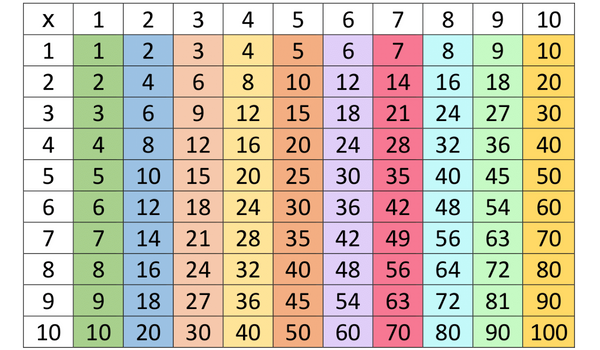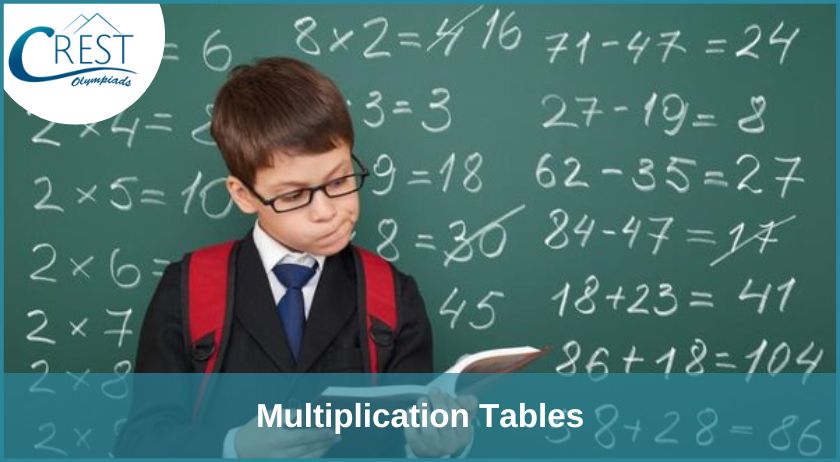Is your kid starting multiplication lessons or preparing for the various Maths Olympiad exams? Then it’s time to teach them multiplication tables.
A Maths table or a multiplication table is a mathematical table used to specify a multiplication operation for an algebraic system. It is also known as the times table. The table of multiplication can be determined by multiplying a number with a set of whole numbers. The Maths table is the foundation of Mathematics. As everyone knows, multiplication is one of the fundamental mathematical operations.
Students can perform calculations more quickly by learning Math tables. This is why students are encouraged to learn multiplication tables as early as possible. An easy method to introduce students to the concept of multiplication is by using a multiplication table chart.
Students often complain that it is very challenging to remember the tables. It becomes more challenging to master the multiplication table for bigger numbers, in particular. Do not be worried about how you will memorize the tables because this article gives an easy way to learn multiplication tables.
What is a Multiplication Chart?
A multiplication chart is a table that displays the product of two numbers. It is customary to write one set of numbers in the left column and another set in the top row. Calculation time and effort are greatly reduced when students utilize a multiplication table chart.
Multiplication Chart 1 to 10
Multiplication charts are quite useful for students to readily learn multiplication tables. These charts make learning interesting for students. The numbers from 1 to 10 are written on the left-most column of the grid and the top-most row of the grid, respectively in the times table for chart 1 to 10. For all other rows and columns, each of the boxes depicts numbers as the product of numbers, one from the top-most row and the other from the left column. The table of multiplication chart is shown below.

Printable Multiplication Chart
20 columns and 20 rows must be created within a large square. The header should be filled from left to right and top to bottom from 1 to 20. Divide the number of the row by the number of the column in each square. Students should place these multiplication charts somewhere so that they can see it every day. Make it a routine to review this chart for multiplication tables every day.
Multiplication Tables from 1 to 20
Multiplication tables are key components for multi-digit calculations and solving problems based on fractions, percentages and factors.
Definition
A list of multiples of a specific number is referred to as a multiplication table. It is a tool for teaching two-number multiplication. Students can quickly and easily calculate answers with the aid of a times table.
Tables from 2 to 5
Tables from 6 to 10
Tables from 11 to 15
Tables from 16 to 20
Importance of Multiplication Tables for Students
Tables from 6 to 10
Tables from 11 to 15
Tables from 16 to 20
Importance of Multiplication Tables for Students
In order to perform simple arithmetic calculations, times tables can be of great assistance. A child's memory is significantly stronger than an adult's. Early lessons leave a lasting impression on the brain and are kept throughout life.
Learning times tables are really essential because it is one of the fundamental topics connecting to different mathematical operations. Students can solve a variety of word problems once they have learned the Maths tables. Also, they can improve their capacity for logical thought and reasoning by using tables. Tables are really simple to use and learn.
The times tables might be very crucial as these -
- Assists the mathematical learning of a student.
- Helps the student understand concepts better.
- Gives the student a solid understanding of multiplication facts.
- Makes it simpler for kids to solve mathematical difficulties.
- Exhibits greater confidence when learning new math concepts if students are proficient in times tables typically.
Easy Ways to Learn Multiplication Tables
Students can learn multiplication tables in an easy way by memorizing the Math times tables. But most of the students have trouble remembering multiplication tables. Here, we've included some practical suggestions on how to study multiplication tables easily.
Here we are offering students a few tricks to learning multiplication tables that make learning multiplication tables more engaging and easy. Refer to the tricks below.
- Practice ‘skip-counting’
- Recite the multiplication table in order
- Practice by writing
- Apply multiplication to real-life
- Identify patterns
Practice ‘skip-counting’ - Start with a single digit, then keep adding that digit. For instance, if you start with 3, continue counting by 3 each time. Therefore, you would say 3, 6, 9 and 12.
Recite the multiplication table in order - Say "2 times 1 is 2, 2 times 2 is 4, 2 times 3 is 6, etc." as an example. Make it a habit to repeat this table once every day until you are familiar with the order that follows.
Practice Reverse Table Recitation - The multiplication table should be stated backward. Start at the bottom of the column. For example, begin with “2 times 20 is 40, 2 times 19 is 38,” etc.
Practice by Writing - Writing and learning are always an option if students are having trouble recalling the multiplication table. Make writing the multiplication tables down and then reciting them once a day a routine.
Apply Multiplication to Real Life - Use examples from everyday life to help you comprehend the multiplication tables. If it's possible, you might also try practicing multiplication in different contexts. For instance, multiplying the amount by the quantity of notes in a bundle or the price of one item by the number of items.
Recognize Patterns - There is a particular pattern for each multiplication table. It is crucial to recognize this pattern. You'll be able to memorize these times tables more quickly.
Examples Questions for Multiplication Tables
Example 1: Ram is paid $8 per hour for his 5 hours of work per day. How much does Ram earn per day?
Solution:
Ram works for 5 hours and is paid $8 per hour. As a result, by using multiplication tables the total amount that he earns is 5 times 8.
Ram earns $40.
Example 2: The price of 1 pencil is Rs. 12. What is the cost of 5 pencils?
Solution:
Price of 1 pencil = Rs. 12
Cost of 5 pencils = Rs. 12 × 5 = Rs. 60
Practice Questions
Learn multiplication tables to get the following product:
4 × 12
5 × 9
8 × 2
14 × 2
16 × 9
12 × 8
13 × 9
18 × 3
15 × 6
17 × 4
Conclusion
With this article, I hope kids can learn about multiplication tables in a fun and easy way. Students can also practice problems and compare their answers to those provided by us.








